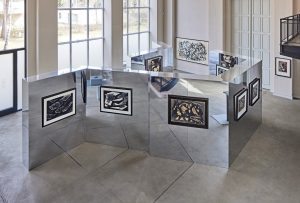04.04.2022 –
19.06.2022
SPATIAL LINES – Graphic Works by Hans Uhlmann, 1933–1960

The exhibition »Spatial Lines: Graphic Works by Hans Uhlmann, 1933–1960« pays tribute to one of the prominent artists in West Germany after 1945. Known above all as a sculptor, this exhibition now concentrates on his graphic work. The occasion for this retrospective exhibition is the publication of Uhlmann’s prison diaries, which are both an intimate document of the agonizing experience of his incarceration and a central aspect of his artistic evolution.
On October 30, 1933, Hans Uhlmann was arrested by the Gestapo on open street. In the Columbia-Haus, he was interrogated for several weeks and then found guilty by the court of appeal of »preparations for a traitorous enterprise.« He spent a year and a half in prison—first in Moabit and then in Tegel Prison. The artist recorded his experiences of those years in diaries. In parallel with these diaries, he produced four books of sketches. In his diary entries Uhlmann describes his arrest as well as scenes from daily life in confinement but above all his artistic concerns and projects: »I often think of freedom; of my first works; I occupy myself here by imagining these figures« (May 5, 1934).
Not being able to realize these ideas was difficult for the artist: »I hope most ardently to be able to work under humane conditions. If I want to work as a sculptor and that isn’t possible, then it is torture« (August 12, 1934). He was therefore all the more hopeful about the period after his release. One central development in Uhlmann’s work can be seen in the idea of using wire for portrait sculptures: »I imagine my drawings, often and entire nights long. I have to work with iron as well, faces and figures from plates (also of copper, for example); the various plates are welded (arc welding), hair from wire?« (October 6, 1934). Almost as soon as he had been released, Uhlmann did indeed produce several portfolios of elaborate designed graphic works as wire figures and as sculptures, the majority of which have since been destroyed and are documented only by photographs.
After the war ended, Hans Uhlmann was finally able to present these works to a wide audience again and received great recognition. He was appointed associate professor at the art school in West Berlin already in 1950. In 1955, 1959, and 1964 he participated in »documenta«, and in 1964 his works were shown at the thirty-second Venice Biennale. Numerous large sculptures by the artist appear in public spaces. Prominent examples in Berlin include »Untitled« (1960–61) in front of the Deutsche Oper and »Untitled« (1963) on the roof of the Philharmonie.
The exhibition »Spatial Lines – Graphic Works by Hans Uhlmann« at the Kunsthaus Dahlem traces the artist’s career, starting from his linear drawings of the 1930s by way of his semi-figurative graphic art of the 1940s to geometric abstraction from 1950 onward.
Albert Weis designed the exhibition architecture. The basis is his work »Changes« (2018/2022), an architectural-spatial installation. It takes up typical elements from the floor plan of the Berlin Philharmonie, whose ridge bears one of Hans Uhlmann’s best-known works. The reflecting walls fragment the exhibition space and open it up to infinity. The angles and slants that break up the real spatial conditions counteract Hans Uhlmann’s experiments with folds and spatial breaks. The outside space is integrated into the exhibition through reflections. This is reminiscent of the multiple descriptions of window views or the acoustic impressions of the outside world that Hans Uhlmann describes in his prison, just as he remembers or imagines life beyond the prison walls.
Furthermore, the mirrors also involve the viewers, putting their point of view to the test through the changed perception of space. The insecurity that arises from this also corresponds to the perception of completely new and often frightening living conditions that Uhlmann was exposed to in prison.